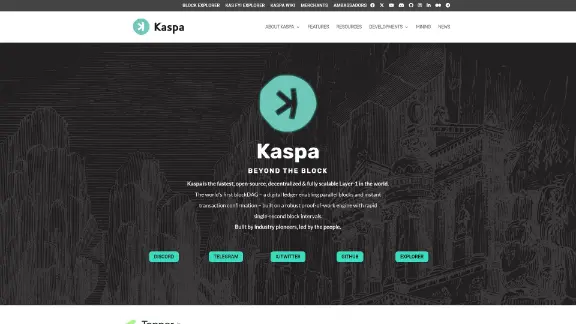Kaspa (KAS)
Kaspa is a layer 1 blockchain utilizing a proof-of-work system and the PHANTOM/GHOSTDAG protocol. It leverages a Directed Acyclic Graph (DAG) to enhance transaction security and efficiency while promoting decentralization and accessibility. Developed by Yonatan Sompolinsky, a contributor to the Ethereum GHOSTDAG protocol, Kaspa launched in 2021 to address scalability issues in traditional blockchains. DAGLabs founded the project, with backing from PolyChain, emphasizing open-source principles and community-driven governance. The protocol is designed for high speed and scalability, using a proof-of-work consensus that matches Bitcoin's security without additional assumptions. Unlike traditional blockchains, PHANTOM allows parallel blocks to coexist, simplifying Bitcoin's consensus process with a focus on decentralization.
Approach and challenges

| Ticker | KAS |
| Category | Smart Contract Platform |
| Website | https://kaspa.org/ |
| @KaspaCurrency | |
| Telegram | kaspaenglish |
| https://www.reddit.com/r/Kaspa |
Kaspa addresses a challenge in the Bitcoin consensus that could allow attacks with less than 51% computational power. By utilizing a DAG, Kaspa allows blocks to reference multiple others, preventing double spending through ordered block formation. This structure supports increased network throughput without compromising security, forming the basis of the GHOSTDAG protocol.
Infrastructure
BlockDAG
Kaspa's infrastructure is built on a block-directed Acyclic Graph (blockDAG), diverging from the linear approach of traditional blockchains. This allows for parallel processing and concurrent transaction confirmations, enhancing throughput and scalability. Blocks are confirmed as soon as they receive sufficient references from other blocks, enabling faster transaction finality.
GhostDAG
GhostDAG, Kaspa’s consensus mechanism, enhances the PHANTOM protocol's principles for efficiency and security. It uses a k-cluster approach, coloring blocks as Blues (within the cluster) and Reds (outside it). GhostDAG employs a greedy algorithm to enhance security, ensuring that reversing block ordering becomes exponentially difficult over time.
Open-source framework
Kaspa embraces an open-source framework to encourage transparency, collaboration, and community-driven development. By allowing public access to its source code, Kaspa fosters trust and innovation, inviting global developers to contribute to its evolution and explore decentralized applications.
Tokens
KAS
KAS is the native cryptocurrency of the Kaspa network, facilitating exchanges and transactions. It serves as an incentive for miners and validators, securing the network through Proof-of-Work. KAS tokens are also integral to network governance, enabling holders to vote on protocol upgrades and changes.
wKAS
The wrapped KAS token (wKAS) is an Ethereum-compatible version of KAS, ensuring interoperability between Kaspa and Ethereum networks. wKAS maintains a 1:1 peg to KAS, allowing users to access Ethereum's decentralized applications while preserving the ability to redeem KAS on the Kaspa blockchain.
History
The Kaspa crash
After its launch, Kaspa experienced a network disruption in November 2021, prompting community discussions and project adjustments to enhance resilience. Modifications included a switch to a deterministic block reward system, and discussions on implementing a deflationary monetary policy were initiated to ensure stability and community support.
The RUST update
In May 2023, Kaspa transitioned its codebase from Golang to Rust, enhancing reliability, security, and performance. Rust’s memory safety features reduce vulnerabilities, while its concurrency capabilities optimize resource use. This update streamlines maintenance and supports future development, positioning Kaspa for growth in the decentralized ledger space.
